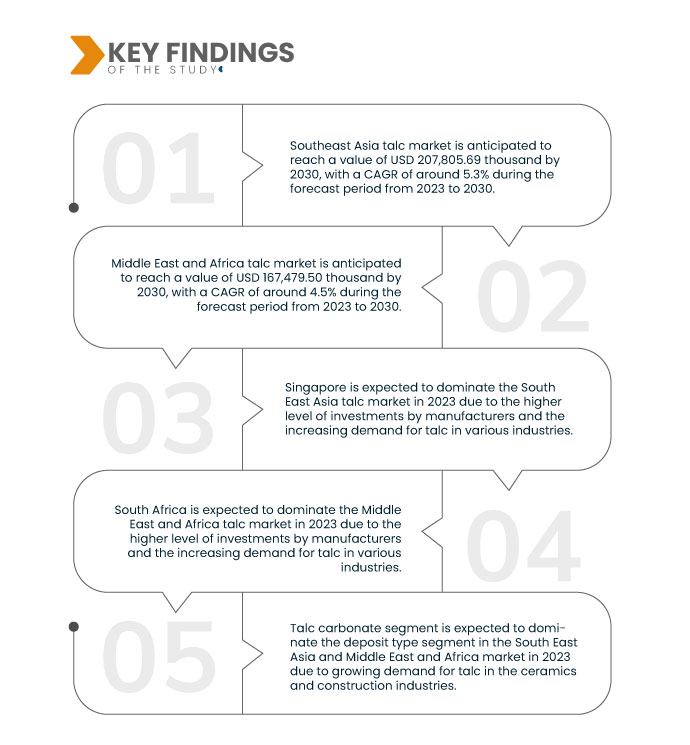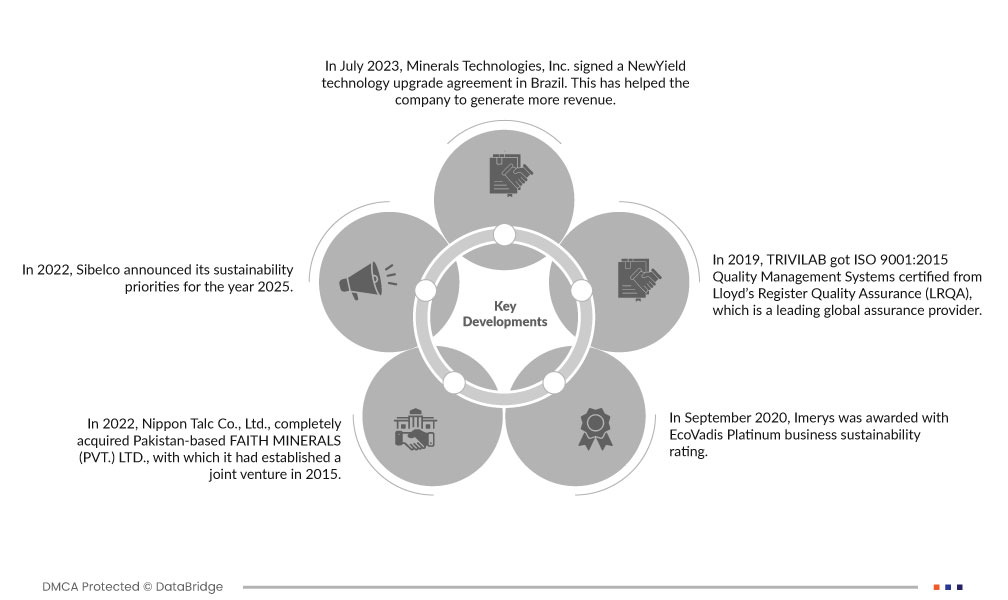Talc is widely used in the ceramics industry as a filler and fluxing agent. It enhances the properties of ceramics, such as whiteness, translucency, and thermal resistance. The demand for ceramic products, including tiles, sanitary ware, and tableware, has been steadily increasing in both South East Asia and the Middle East and Africa due to population growth, urbanization, and construction activities. As a result, the demand for talc in the ceramics sector has been on the rise, which is expected to drive market growth.
Access Full Report @ https://www.databridgemarketresearch.com/ko/reports/south-east-asia-and-middle-east-and-africa-talc-market
Data Bridge Market Research analyzes that the South East Asia and Middle East and Africa Talc Market is expected to reach the value of USD 207,805.69 thousand by 2030, at a CAGR of 5.3% during the forecast period. The Middle East and Africa talc market is expected to reach a value of USD 167,479.50 thousand by 2030, at a CAGR of 4.5% during the forecast period. The talc carbonate in the deposit type segment is providing the largest share of the market due to the growing demand for talc in the ceramics and construction industries.
Key Findings of the Study
Increasing Use of Talc in the Agriculture Sector as a Filler and Carrier in Pesticides and Fertilizers
Talc acts as a functional filler and carrier in agricultural products such as pesticides and fertilizers. It helps improve the handling and application characteristics of these formulations by enhancing their flow ability and reducing caking or clumping. The addition of talc ensures that the active ingredients in pesticides and fertilizers are evenly distributed, leading to more effective and consistent application on crops.
South East Asia and the Middle East and Africa are regions with significant agricultural activities. Agriculture is a crucial sector in these areas, contributing significantly to their economies and food security. There is a parallel rise in the usage of agrochemicals such as pesticides and fertilizers as the demand for agricultural products increases to meet the growing population's needs. This, in turn, drives the demand for talc as a vital component in these formulations.
Thus, the growing demand for talc in the agriculture sector is expected to drive market growth.
Report Scope and Market Segmentation
|
Report Metric
|
Details
|
|
Forecast Period
|
2023 to 2030
|
|
Base Year
|
2022
|
|
Historic Years
|
2021 (Customizable to 2015-2020)
|
|
Quantitative Units
|
Revenue in USD Thousand, Volumes in Units, Pricing in USD
|
|
Segments Covered
|
Deposit Type (Talc Carbonate, Talc Chlorite, and Others), End Use (Pulp & Paper, Plastic & Polymer Industry, Paints & Coatings, Ceramics, Rubber Industry, Cosmetics & Personal Care, Food Industry, Pharmaceuticals, Agriculture, Adhesives & Sealants, and Others)
|
|
Countries Covered
|
Singapore, Indonesia, Malaysia, Thailand, Rest of South East Asia, South Africa, Saudi Arabia, U.A.E., Israel, Egypt, Qatar, and Rest of Middle East and Africa
|
|
Market Players Covered
|
Imerys (Paris), Sibelco (Belgium), Minerals Technologies Inc.(U.S.), ELEMENTIS PLC. (U.K.), TRIVLAB (Indonesia), IMI Fabi SpA (Italy), Nippon Talc Co., Ltd.(Japan), and Kaolin (Malaysia) Sdn Bhd. (Malaysia)
|
|
Data Points Covered in the Report
|
In addition to the insights on market scenarios such as market value, growth rate, segmentation, geographical coverage, and major players, the market reports curated by the Data Bridge Market Research also include in-depth expert analysis, geographically represented company-wise production and capacity, network layouts of distributors and partners, detailed and updated price trend analysis and deficit analysis of supply chain and demand.
|
Segment Analysis
The South East Asia and Middle East and Africa talc market is segmented into two notable segments based on deposit type, and end use.
- On the basis of deposit type, the market is segmented into talc carbonate, talc chlorite, and others.
In 2023, the talc carbonate segment is expected to dominate the South East Asia and Middle East and Africa talc market
In 2023, the talc carbonate segment is expected to dominate the South East Asia talc market with a market share of 50.20% due to the growing demand for various talc products by various industries.
In 2023, the talc carbonate segment is expected to dominate the Middle East and Africa talc market with a market share of 50.72% due to expanding industrial applications of talc in paints, coatings, plastics, and rubber products.
- On the basis of end use, the market is segmented into Pulp & Paper, plastic & polymer industry, paints & coatings, Ceramics, rubber industry, cosmetics & personal care, food industry, pharmaceuticals, agriculture, Adhesives & Sealants, and others.
In 2023, the pulp & paper segment is expected to dominate the South East Asia and Middle East and Africa talc market
In 2023, the pulp & paper segment is expected to dominate the South East and Asia talc market with a market share of 17.51% due to expanding industrial applications of talc in paints, coatings, plastics, and rubber products.
In 2023, the pulp & paper segment is expected to dominate the Middle East and Africa talc market with a market share of 18.23% due to the increasing use of talc in the automotive industries.
Major Players
Data Bridge Market Research recognizes the following companies as the major market players in the South East Asia and Middle East and Africa talc market that include Imerys (Paris), Sibelco (Belgium), Minerals Technologies Inc. (U.S.), ELEMENTIS PLC. (UK), TRIVLAB (Indonesia), among others.
Recent Developments
- In July 2023, Minerals Technologies, Inc. signed a NewYield technology upgrade agreement in Brazil. This has helped the company to generate more revenue.
- In 2022, Sibelco announced its sustainability priorities for the year 2025. These priorities are aligned with the United Nations’ Sustainable Development Goals and demonstrate Sibelco’s commitment to creating economic, social, and environmental value. This showcases the company’s focus on global initiatives for a green and clean environment and climate. This attracts different consumers.
- In 2022, Nippon Talc Co., Ltd., completely acquired Pakistan-based FAITH MINERALS (PVT.) LTD., with which it had established a joint venture in 2015. The company is now a 100% owned subsidiary of Nippon Talc Co., Ltd. This will enhance the company’s market share and improve its footprint in the business.
- In September 2020, Imerys was awarded with EcoVadis Platinum business sustainability rating. This has enhanced the company’s image in the market and placed Imerys in the top 1% of companies assessed worldwide.
- In 2019, TRIVILAB got ISO 9001:2015 Quality Management Systems certified from Lloyd’s Register Quality Assurance (LRQA), which is a leading global assurance provider. This will enhance the level of quality of products, processes, and services of the company.
Country Analysis
Geographically, the countries covered in this market report are Singapore, Indonesia, Malaysia, Thailand, Rest of South East Asia, South Africa, Saudi Arabia, U.A.E., Israel, Egypt, Qatar, and Rest of Middle East and Africa.
As per Data Bridge Market Research analysis:
Singapore is the dominant and fastest growing country in the South East Asia talc market
Singapore is expected to dominate and be a fastest growing country in the South East Asia region due to the presence of many major players operating in the country.
South Africa is the dominant and fastest growing country in the Middle East and Africa talc market
South Africa is expected to dominate and be a fastest growing country the Middle East and Africa region due to the increase in initiatives such as acquisitions, collaborations, and product launches by manufacturers to distribute their products efficiently to the consumer.
For more detailed information about the South East Asia and Middle East and Africa talc market report, click here – https://www.databridgemarketresearch.com/ko/reports/south-east-asia-and-middle-east-and-africa-talc-market















